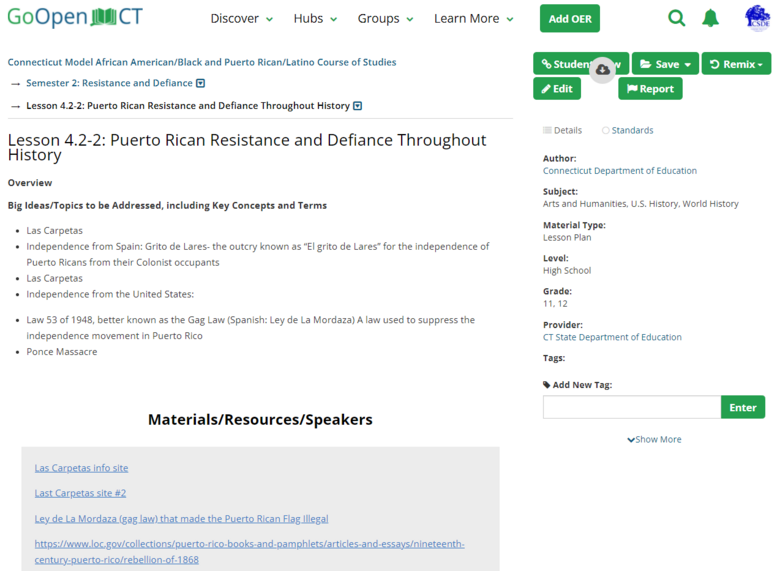Lesson 4.2-2: Puerto Rican Resistance and Defiance Throughout History

Overview
Big Ideas/Topics to be Addressed, including Key Concepts and Terms
Las Carpetas
Independence from Spain: Grito de Lares- the outcry known as “El grito de Lares” for the independence of Puerto Ricans from their Colonist occupants
Las Carpetas
Independence from the United States:
Law 53 of 1948, better known as the Gag Law (Spanish: Ley de La Mordaza) A law used to suppress the independence movement in Puerto Rico
Ponce Massacre
Materials/Resources/Speakers
Ley de La Mordaza (gag law) that made the Puerto Rican Flag Illegal
Grito de Lares Everything you Wanted to Know - Puerto Rico Flag
Ponce Massacre March 21, 1937: Ponce Massacre
Ponce Massacre summary- (trigger warning) The Ponce Massacre
Ponce Massacre in the media-
War Against All Puerto Ricans: Inside the U.S. Crackdown on Pedro Albizu Campos & Nationalist Party
Ley de La Mordaza (gag law) that made the Puerto Rican Flag Illegal
Invasión del Partido Nacionalista y el arresto de Pedro Albizu Campos (Arrest of Pedro Albizu Campos in Spanish only)
Big Brother in Puerto Rico: How the FBI Knew Everything About You
Recommended Learning Activities, including UDL Principles/Scaffolded Supports and Asynchronous and Synchronous Learning Opportunities
Day 1
Initiation: Begin with a mini-lesson about “La Carpeta” framing around the themes of resistance and defiance.
Activity: After learning about “La Carpeta”, students discuss:
Why was it done?
Was it ethical?
Were there any other solutions or things that could have been done?
Was the U.S. feeling “threatened”?
Day 2
Initiation: Provide a mini-lesson on La Ley De La Mordaza using Puerto Rican Flag History / Law 53 / Gag Law / La Ley De La Mordaza or The Gag Law-Ley De La Mordaza Presentation.
Closing: Students use Exit Slip to respond to how the Puerto Ricans have demonstrated resistance through fight and flight tactics when their people, homes, identity, and culture were threatened.
Day 3
Activity: Students receive the PR’s Resistance Groups Activity. Teacher reviews background and directions, and breaks students up into the three groups for research on the specific organizations: Young Lords, FALN, and Los Macheteros. Students work on completing Google Jamboard for their group. Then they share their findings with the class.
Closing/Evidence of Learning: Students complete and submit table demonstrating understanding and examples of these three pro-independence groups.
Day 4
Activity: Students watch a video on the El Grito de Lares and Ponce Massacre, and students take notes and compare and contrast using graphic organizer.
Closing: Students use reflection strategy (4 things that squared with me, 3 things I learned (triangle), and 2 things still circling in my head) to reflect on what they learned about Puerto Rican resistance and defiance.
Home Links/Reflections to Affirm Identity
With the Puerto Rican Flag in mind, interview a family member and ask them about the history of the flag of their family’s origin. Everything you Wanted to Know - Puerto Rico Flag
Students read How “Que Bonita Bandera” Became a Revolutionary Puerto Rican Anthem with their families
Students ask their family members how they would feel if it became illegal to display their country’s flag as Puerto Rico did in 1948 with Law 53.
Options for Content Continuity Across History Courses and Interdisciplinary Integration
English
U.S. History
Political Science
Extensions/Experiential Opportunities
Students research and investigate different national Puerto Rican Movements. In pairs, students pick one group and do quick research regarding main arguments/tactics for independence. Students engage in another boxing strategy to capture their notes on the learning. In the outside frame, students write prior knowledge and what they want to learn by this investigation. In the second box, they write about their new learning. In the middle they write a summary of new learning or draw an image that synthesizes the group’s understanding of the topic and post summaries of their new learning.
Groups:
Boricua Popular Army
Cadets of the Republic
Fuerzas Armadas de Liberación Nacional Puertorriqueña
Hostosian National Independence Movement
Independence Association of Puerto Rico
Liberal Party of Puerto Rico
Puerto Rican Independence Party
Puerto Rican Nationalist Party
Revolutionary Committee of Puerto Rico Socialist Front
Union Party of Puerto Rico
Students read Big Brother in Puerto Rico: How the FBI Knew Everything About You (latinorebels.com) Then, students engage in a Four Corners Protocol in which the teacher reads a statement, students think about their answer, and students respond by moving to a corner of the room that best corresponds to their choice and discuss. Each corner is marked by a chart (strongly agree, agree, disagree, strongly disagree). Teachers may use statements such as:
It is ethical for corporations and the government to observe us and monitor our information.
The FBI should be able to collect information without a warrant issued by a judge.
If you haven’t done anything wrong, you have nothing to worry about the FBI collecting information on you.
The FBI must collect public and private information on people.
It was fine that Las Carpetas were used to arrest people and impact reputations, careers, and families.
Public Law 53 (Gag Law, Ley de la Mordaza) was wrong because it was a felony to say a word, sing a song, own a Puerto Rican flag, or whistle a tune about independence.
It is not an intrusion when the government collects information on individuals.
There would be negative consequences if the FBI did not collect information on people.
The FBI must collect information as long as the information that is gathered is not causing harm to the individual.